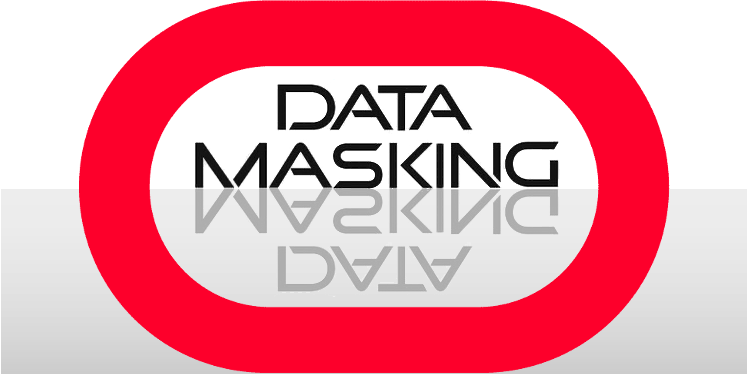Oracle data masking hides sensitive data in its own non-production databases using realistic fake data, to help protect privacy and reduce storage costs.
The data masking process unmasked
The process of data masking securely conceals sensitive data within a database. It’s useful, for example, in cases when realistic data is required for testing, but actual customer information like Social Security Numbers (SSNs) can’t be exposed. Data masking processes, when done well, let you create a disguised version of your data, replacing real values with fictitious but functionally similar ones.
Masking data protects Personally Identifiable Information (PII) while allowing users to work with the data in lower environments that behave just like the real thing. It helps organizations comply with data privacy regulations and minimizes the risk of exposing sensitive information in non-critical environments like development or testing databases. By masking data, you can safely share it with developers, testers, or partners without compromising real customer information.
What is Oracle data masking?
Oracle data masking is part of the suite of Oracle data management and testing tools that offers basic data masking options like shuffling, encryption, and randomization, as well as more traditional methods like nulling out. Oracle data masking can be effective for simple test environments and other situations where there’s a need for data that functionally behaves like the real thing but can’t contain actual values for security reasons.
In general, Oracle data masking works by replacing real data with fictitious but functionally similar information. For example, it could replace SSNs with random sequences, while still retaining the same XXX-XX-XXXX format. The Oracle masking solution can also reduce the amount of data shared by extracting only relevant subsets of a given dataset – for example by selecting specific data based on criteria like time period or geographical location.
How does Oracle data masking work?
Oracle data masking anonymizes sensitive data within your Oracle databases. It replaces real information with fake data that tries to maintain functionality for development, testing, or analytics. Here's how it works:
-
Sensitive data discovery
Oracle helps identify and classify sensitive data like passport numbers or credit card details. Sensitive data discovery helps define what information needs to be masked.
-
Masking methods
Oracle lets you choose your data masking method, including:
| Method | Explanation |
|
Shuffling |
Reordering data within a column (e.g., salaries) to break the link between specific values and individuals |
| Substitution | Replacing real values with fictitious ones (e.g., fake names or driver’s license numbers) while maintaining data type (e.g., keeping phone numbers ten digits long) |
| Regular expressions | Applying complex patterns for advanced masking needs and more granular control (e.g., defining patterns that match specific formats, like email addresses or credit card numbers) |
- Masking policies
You define rules for masking specific columns. This includes selecting the masking format and any additional customization. - Data transformation
Oracle applies the chosen masking formats to the data. This can be done during data export (at-source masking) or directly within the database. - Validation
The masked data is checked to ensure sensitive information is truly anonymized and the data retains functionality for its intended use.
Benefits of Oracle data masking
Oracle data masking offers several advantages for organizations trying to balance data security with functionality:
-
Enhanced data security
PII masking minimizes the risk of exposing private information like credit cards or customer names in non-production environments. This helps organizations comply with data privacy regulations and reduces the potential damage in the event of a data breach.
-
Improved development efficiency
Developers and testers can work with realistic data that behaves functionally like real data. With no need for sanitized data or limited datasets, development cycles are accelerated.
-
Secure collaboration
Anonymized data can safely be shared with external partners for testing or analytics purposes without compromising sensitive information – fostering collaboration and streamlining workflows.
-
Reduced storage costs
Data masking tools allow for the creation of smaller, anonymized datasets for non-production environments. This feature significantly reduces storage requirements and associated costs.
-
Simplified regulatory compliance
Data obfuscation promotes data protection by providing an auditable log of masking activities. This capability simplifies compliance audits for regulations like GDPR, CPRA, and HIPAA.
Oracle data masking barriers
Oracle data masking is a point solution providing data security within Oracle ecosystems. Its integration with Oracle databases simplifies the masking process, but all solutions have their hurdles. Notably, data teams operating in multi-database environments have found that the platform is extremely complex, even for experienced users – and that their non-Oracle databases require separate solutions. They must also consider the following potential barriers:
-
Operational performance
Extensive masking, especially using complex techniques like regular expressions, can slow down database operations. Large datasets might experience noticeable performance drops during the masking process.
-
Referential integrity and semantic consistency
Striking the right balance between anonymization and data usability can be tricky. Overly aggressive masking might distort data relationships or render it unusable for its intended purpose in non-production environments.
-
Data lineage
Tracking how masked data relates back to the original data can be complex and hinder troubleshooting or understanding the origin of masked values used in reports or analytics.
-
Ongoing security
New masking techniques might be required as hackers develop methods to potentially reverse engineer masked data. Striving to maintain the highest data making standard is crucial.
-
Schema sync
Keeping masking policies synchronized with schema changes can be a time-consuming task, especially in large databases that undergo frequent updates.
Beyond Oracle data masking with K2view
K2view offers a fully-integrated alternative to Oracle data masking that combines an innovative business entity approach with advanced data masking techniques.
The company’s entity-based data masking technology discovers, ingests, organizes, and masks sensitive data on the fly. Sophisticated data discovery functionality identifies PII within the context of each business entity (an individual customer, product, order, etc.). Modelling the data in this way allows for exceptional accuracy in pinpointing PII and preventing accidental exposure.
K2view data masking software extends beyond the traditional methods available through the Oracle toolkit – and can anonymize data from any source (Oracle or not) regardless of format (structured or unstructured). It maintains referential integrity and sematic consistency across all databases, ensuring masking accuracy and intelligence when dealing with data from many different sources.
More importantly, K2view offers a centralized approach to data anonymization, eliminating the need for individual licenses per data source as is required by Oracle – resulting in significant cost savings for businesses managing data privacy across diverse systems.
Learn more about K2view data masking tools for Oracle and all other data sources.














